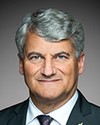Thank you, Mr. Chair.
Honourable members, as the deputy minister of Transport Canada, I'm happy to be back in front of the public accounts committee. I look forward to the opportunity to discuss the Auditor General's report on civil aviation infrastructure in the north.
We welcome this review as an opportunity to strengthen our efforts to maintain safe and efficient air services in the north, a key priority for the Government of Canada.
This report of the Auditor General focused on airport infrastructure issues rather than aviation safety issues. The report made two recommendations: that Transport Canada lead the development of a long-term strategy for northern airport infrastructure, and work with stakeholders to determine potential sources of funding. The department agrees with both of the Auditor General's recommendations and has identified steps to respond to them.
The first recommendation, specifically, is that “Transport Canada, in collaboration with stakeholders, should lead the development of a long-term strategy for northern airport infrastructure. The strategy should clearly outline the role that Transport Canada will play in addressing the infrastructure needs of remote northern airports.”
Transport Canada is a key participant in the development of the new Arctic policy framework that was announced by Prime Minister Trudeau in December 2016. Led by the Minister of Crown-Indigenous Relations and Northern Affairs, the government is consulting and collaborating on the development of the Arctic policy framework to promote strength, prosperity, health, and sustainability in the Arctic.
One of the Arctic policy framework's main themes will be comprehensive Arctic infrastructure, which of course includes transportation and, in particular, air transportation. In support of this work, and to address northern transportation needs in the longer term, Transport Canada is working with its territorial counterparts to develop a federal transportation framework to better articulate and focus its approach to the unique transportation challenges of the north. This framework would help guide the range of policy, investment, and regulatory measures that can enable new social and economic opportunities in Canada's Arctic and northern regions. A key element of the framework will be the need for stronger partnerships between governments, local communities, and the private sector.
The Auditor General's second recommendation is that Transport Canada should work with the provinces, territories, and stakeholders to determine what sources of funding will meet the infrastructure needs of remote northern airports.
It should be noted here that Transport Canada neither owns nor operates the airports examined in the Auditor General's report, and that identification of the infrastructure needs of these airports should be led by the owners and operators of these facilities. That said, we agree that northern communities have unique infrastructure needs that require a more targeted approach to investment than those in the south, and that we need to exercise leadership in moving forward on that.
In fact, this year the Government of Canada confirmed federal intentions to improve critical transportation infrastructure in Canada, in particular in Canada's north. The national trade corridors fund was announced on July 4. Of its $2 billion over 11 years, up to $400 million has been targeted to specifically address the unique transportation needs of Canada's territorial north. Expressions of interest have already been received, including several submissions for improving northern airport infrastructure. Applications for the first round of funding are due by November 6, and we anticipate the funding decisions in this first round will be announced next spring. In addition, Transport Canada plans to make northern infrastructure a priority in the upcoming round of this new program.
The Auditor General's report is very helpful as we continue to work closely with territorial counterparts, provincial governments, and local jurisdictions operating northern and remote airports. Our work includes a range of activities—teleconferences, site visits, and webinars—to ensure full consultation as we develop a plan for moving forward that is centred on the national trade corridors fund and other possible sources of funds. This increased engagement is resulting in a deeper understanding of the issues and transportation needs in remote and northern air infrastructure, and will be the basis of developing plans going forward.
Mr. Chair, we look forward to the committee's questions and comments on this important matter.




